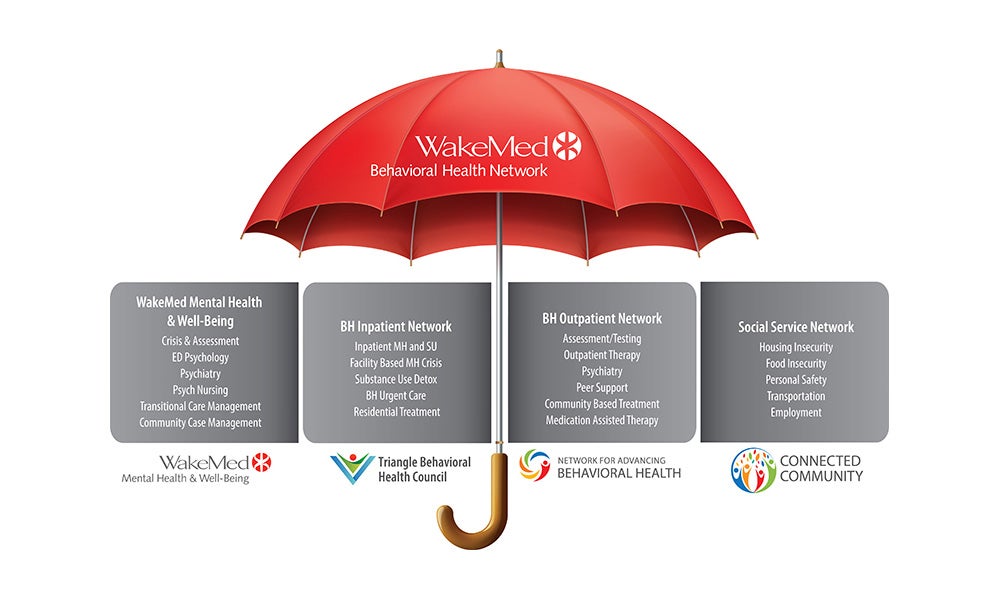Behavioral Health Network
In 2017, a network of Behavioral Health (BH), social service, and primary care providers teamed up with WakeMed Health and Hospitals in Raleigh, NC to build a network of high performing BH providers to improve access and care coordination for patients suffering from mental and chronic health conditions. In partnership with Blaze Advisors, the WakeMed Behavioral Health Network (WMBHN) set out to build a highly collaborative and integrative model of care that would improve disease detection, accelerate access to the right care/provider and improve patient engagement — to keep patients out of the ED and reducing readmissions.
In the years since its inception, WMBHN developed several high performing networks and collaborative partners. One such network is the Network for Advancing Behavioral Health (NABH), a preferred behavioral health referral network.
The NABH does not directly provide services; that is the role of its individual members. The NABH coordinates the white space between levels of care, providers, specialties and even the patient and their clinical team. The NABH has the flexibility to deploy tools and programs at a “system of care” level difficult for any single provider or specialty to launch. Yet our primary role is one of “convener” and “translator:” bringing network experts together, empowered by clinical data, to identify pragmatic solutions to stubborn challenges.
Behavioral Health Network Services
The NABH is comprised of local and statewide behavioral health providers that collectively offer a full continuum of behavioral health services. In exchange for timely access to care, WakeMed Health and Hospitals sends referrals to a small group of preferred providers, alleviating long lengths of stay for the over 90,000 patients who present at WakeMed with a primary or co-occurring behavioral health condition. On the eve of accountable care and value-based purchasing, however, NABH leadership decided to form itself into a high-performance network. It supports these systemic solutions:
- Early disease identification and intervention
- Risk stratification and pre-crisis mitigation
- Accelerated and coordinated access to primary and BH care
- Patient activation (starting treatment) and engagement (fidelity to care plan)
- Whole Person Care, including Social Determinant Obstacles to Health (SDOH)
- Using technology and innovation to improve communication and increase capacity
Today, the NABH works closely with primary care, medical and psychiatric hospitals, residential treatment facilities and social service organizations through our sister network, the Connected Community. Together, these organizations have made a significant and measurable impact:
- Increased early identification of clinical and medical conditions that, if left untreated, can confound wellness.
- Reduction in the use of unnecessary involuntary commitments by presenting structured aftercare programs as alternatives
- More appropriate and timely use of intensive inpatient resources by higher acuity/risk patients.
- Increased attendance to first and second appointments through team-based care and stigma reduction.
- Improved health resiliency through decreased avoidable 30-day readmissions to hospitals.
While the NABH continues to seek out and welcome any financial incentive(s) that supports our effort, all of the NABH members agree that our primary reason for working together is simply that it is the right thing to do.
We want to expand the NABH.
Partner with us.
Why join?
Improve health status and enhance quality of life for patients requiring behavioral health support.
Identify patients who are a best fit for your services.
Support patients for early intervention and identification of disease patterns.
Accelerate and coordinate across the network.
Learn more about joining the NABH
Call 919-350-5906The Right Care. The Right Environment. The Right Time.
Key elements that provide the underpinning of the WMBHN and the NABH include:
- The use of communal screening and risk assessment tools
- Referral and patient engagement technology to share clinical information and monitor health outcomes
- Accountable, multi-specialty, managed systems of care connected by shared communication tools and clinical insights
- Transitional care support to mitigate social obstacles to treatment adherence
- Advanced risk modeling and workflow alerts to preempt crisis and health events
In addition to a suite of analytic, reporting, and remote patient engagement tools, the network uses the interoperable Care Optimization System© (COS) to send referrals, coordinate care, and track patient migration throughout the network. The solution provides secure communications across the community to share alerts, observations, and clinical information. All members of the network agree to singularly and jointly measure key performance metrics including screening rates, timely access to care, 30-day readmissions, treatment/medication adherence, and avoidable inpatient bed days.
To track and evaluate outcomes, the WMBHN also uses a population health management platform — the Clinical Intelligence Engine© (CIE) — to aggregate various data elements across shared workflows and platforms. The analytics and reports generated from the CIE provide insight into population dynamics and nuances as well as drives decision making and overall network performance.
